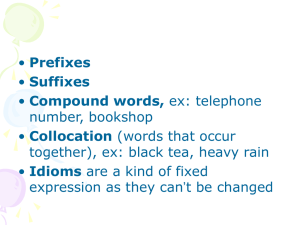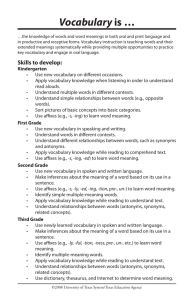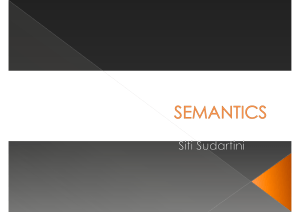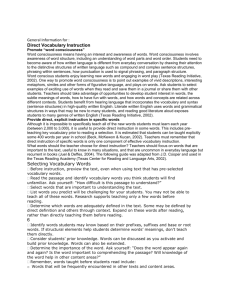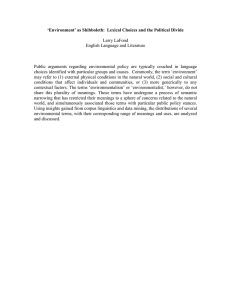Lexicology, Etymology & Word Formation Lecture Notes
advertisement
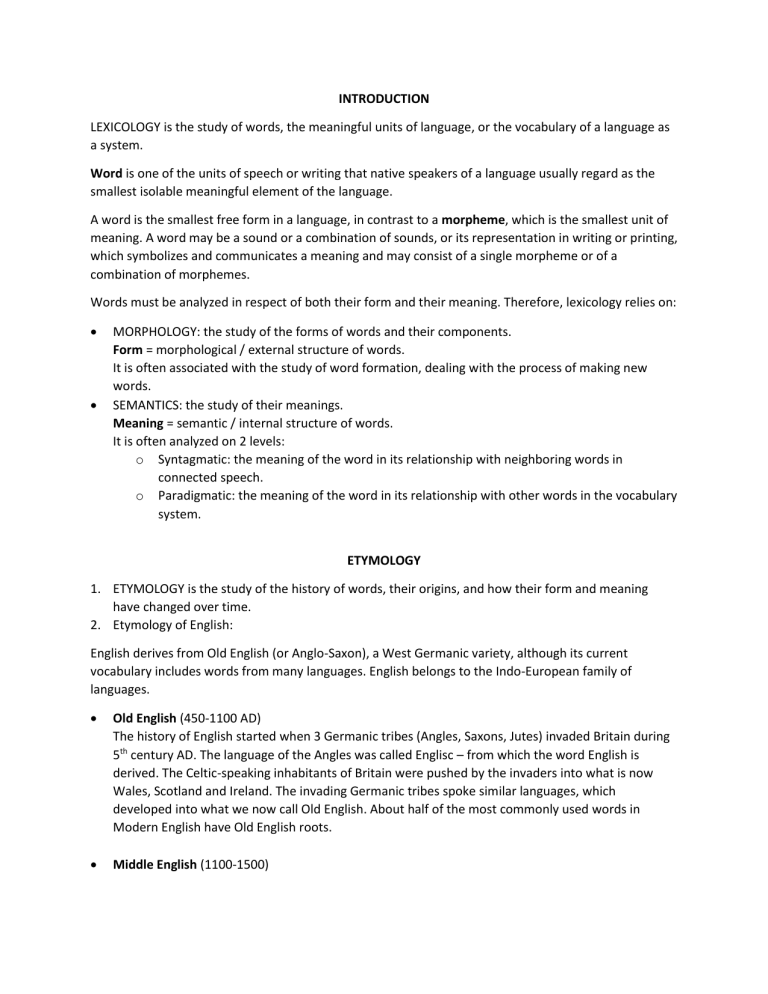
INTRODUCTION LEXICOLOGY is the study of words, the meaningful units of language, or the vocabulary of a language as a system. Word is one of the units of speech or writing that native speakers of a language usually regard as the smallest isolable meaningful element of the language. A word is the smallest free form in a language, in contrast to a morpheme, which is the smallest unit of meaning. A word may be a sound or a combination of sounds, or its representation in writing or printing, which symbolizes and communicates a meaning and may consist of a single morpheme or of a combination of morphemes. Words must be analyzed in respect of both their form and their meaning. Therefore, lexicology relies on: MORPHOLOGY: the study of the forms of words and their components. Form = morphological / external structure of words. It is often associated with the study of word formation, dealing with the process of making new words. SEMANTICS: the study of their meanings. Meaning = semantic / internal structure of words. It is often analyzed on 2 levels: o Syntagmatic: the meaning of the word in its relationship with neighboring words in connected speech. o Paradigmatic: the meaning of the word in its relationship with other words in the vocabulary system. ETYMOLOGY 1. ETYMOLOGY is the study of the history of words, their origins, and how their form and meaning have changed over time. 2. Etymology of English: English derives from Old English (or Anglo-Saxon), a West Germanic variety, although its current vocabulary includes words from many languages. English belongs to the Indo-European family of languages. Old English (450-1100 AD) The history of English started when 3 Germanic tribes (Angles, Saxons, Jutes) invaded Britain during 5th century AD. The language of the Angles was called Englisc – from which the word English is derived. The Celtic-speaking inhabitants of Britain were pushed by the invaders into what is now Wales, Scotland and Ireland. The invading Germanic tribes spoke similar languages, which developed into what we now call Old English. About half of the most commonly used words in Modern English have Old English roots. Middle English (1100-1500) In 1066 William the Conqueror, the Duke of Normandy (part of France today), invaded and conquered England. French became the language of the Royal Court and the upper classes, while the lower classes continued to speak English. In the 14th century, English became dominant in Britain again, but with many French words added. This language is called Middle English. Modern English o Early Modern English (1500-1800) The Great Vowel Shift started at the end of Middle English, with vowels being pronounced shorter and shorter. Contact with people from other countries and the Renaissance led to many new words entering the language. The invention of printing brought standardization to spelling and grammar, and the dialect of London, where most publishers were, became the standard. In 1604 the first English dictionary was published. o Late Modern English (1800-present) Late Modern English has many more words compared to Early Modern English, because of two reasons: the Industrial Revolution and new technology created a need for new words, and the British Empire at its height conquered many countries, from which the English language adopted foreign words. 3. Borrowed words in the English language: The vocabulary of any language consists of two groups – the native words and the borrowed words. a. Types of borrowings: International words Words of identical origin that occur in several languages as a result of simultaneous or successive borrowings from one ultimate source are called international words. E.g. scientific, technological (radio), political terms (democracy), terms of arts and sports (golf), imported fruits and food (coffee, cocoa). Etymological doublets One of a pair of (or several) words more or less similar in meaning and phonation, appearing in language as the result of borrowing from the same source at different times. E.g. hospital (Latin) – hostel (Norman French) – hotel (Paris French); to capture – to catch – to chase Translations-loans (calques) Translation loans are words and expressions formed from the material already existing in the language but according to patterns taken from another language, by way of literal word-for-word or root-for-root translation. E.g. wonder child (German: wunderkind); first dancer (Italian: prima ballerina) Hybrids A hybrid is a word whose different elements are of etymologically different origin. E.g. automobile (Greek: auto – self, Latin: mobilis – moveable); homosexual (Greek: homos – same, Latin: sexus – gender) b. Changes to borrowings Phonetic assimilation: changes in sound and stress. Sounds that are unfamiliar to the English language were replaced by similar native sounds. E.g. café The stress on the final syllable of words borrowed from French or Latin was transferred to the first syllable. E.g. honour, reason Grammatical assimilation: Borrowed words acquire new grammatical categories and paradigms by analogy with other English words. However, some words retain their foreign inflexions or have two plural forms. E.g. coconut – coconuts, phenomenon – phenomena, formula – formulae/formulas Semantic assimilation: adopt only one of the original meanings, or acquire new meanings not found in its former semantic structure. E.g. move (Eng) – mouvoir (French) WORD FORMATION Word formation or word building is the process of creation of new words from the resources of a particular language. 1. Basic concepts MORPHEME: smallest component of a word or other linguistic unit that has semantic meaning. o Free morphemes: can stand by themselves o Bound morphemes: cannot stand on their own but need to be attached to a free morpheme. o Morphemes that derive new words, or that are used to create new words, are called derivational morphemes. ROOT: the basic part of a word which cannot be further analyzed without total loss of identity. It is the part of the word left when all affixes are removed. STEM: part of the word to which grammatical affixes are added. A stem may consist of a root or a root plus derivational morphemes. BASE: every form to which an affix can be added is a base. Root, stem = base. AFFIX: o Affix: collective term referring to a bound morpheme joined before, after, or within a root or stem. o Prefix: occurs in the front of a root/stem. o Suffix: occurs at the end of a root/stem. o Infix: occurs inside of a root/stem. PARADIGM: the system of grammatical forms of a word. E.g.: the verbal paradigm of ‘learn’: learns, learned, learning. 2. Types of words + word formations: ROOT WORDS: Words that only have a root morpheme in its structure. DERIVED WORDS: Words that have a root and an affix. COMPOUND WORDS: Words that have 2 or more stems. CONTRACTED WORDS: Words that are formed by contracting certain elements of an existing word or word group. a. DERIVATION / AFFIXATION is the formation of new words by adding affixed to other words or morphemes. Etymological Native affixes Productive Productive affixes (can be used to form new, occasional or potential words readily understood by speakers of a language) Borrowed affixes (Latin, Greek) Non-productive affixes Semantic Prefixes of location time and order size number attitude Negative prefixes Functional Noun-forming Pejorative prefixes Adverb-forming Adjective-forming Verb-forming b. CONVERSION (zero-derivation) is the formation of new words by changing the part of speech of existing ones with their morphemic shape unchanged. E.g. Adv -> N: ups and downs Adj -> N: a native V -> N: talk the talk, walk the walk Adj -> V: to green (to plant trees on), to yellow (to turn into yellow color) N -> V: to access, to eye Grammatically: A word formed by conversion has a new paradigm peculiar to its new part of speech. Semantically: A word formed by conversion has a slightly different meaning from that of the original word, but there are certain semantic or logical associations between the two. c. COMPOSITION / COMPOUNDING is the formation of new words by combining 2 or more existing words. Structural NEUTRAL: formed by combining 2 stems without using linking elements. Simple neutral compounds: both components are roots words Derivational compounds: 1 or both components are derived words Contracted compounds: 1 component is a contracted word Semantic IDIOMATIC: compounds whose meanings do not correspond to the meanings of their components. Meaning partially changed E.g. black-market Meaning completely changed or lost E.g. happy-go-lucky MORPHOLOGICAL: formed by combining 2 stems with the help of a linking vowel or consonants. NON-IDIOMATIC: compounds whose meanings can be seen as the sum of the meanings of their components. SYNTACTIC: strings of words formed from segments of speech, preserving in their structure the syntagmatic relation typical of speech. Compounds vs Word combinations Graphically Phonetically Semantically Syntactically + Morphologically Components of a compound are often joined or hyphenated (except some compound adj used after a linking verb) Only one stress falling on the first syllable (except some compound adj: open-minded, well-known..) Expresses only 1 concept A complete unity indivisible, belonging to the same part of speech. No extra word can be added. Words in a word combination are always separate Each word has a stress of its own Expresses 2 or more concepts Each word is an independent unit belonging to a different part of speech. Extra words can be added. d. SHORTENING / CONTRACTION is the formation of new words by contracting certain elements of existing words or word groups. Clipping: excluding certain part of the existing word. o Initial: E.g. telephone -> phone o Final: E.g. laboratory -> lab o Initial-final: E.g. influenza -> flu o Medial: E.g. mathematics -> maths Abbreviation: a word is formed from the initials of a group of words. Blending: merging parts of existing words into one to form a new word. o The beginning of a word + the end of another: brunch = breakfast + lunch o The beginnings of 2 words combined: cyborg = cybernetic + organism o Blending around a common sequence of sounds: motel = motor + hotel e. Minor types of word formation ONOMATOPOEIA / SOUND IMITATION is the creation of words from sounds that resemble those associated with the objects or actions to be named or that seem suggestive of its qualities. REDUPLICATION is the formation of words by repeating root or stem of a word, or part of it, either without any phonetic changes, or with a variation of the root – vowel or consonant. o Rhyming: e.g. super-duper, walkie-talkie o Exact: e.g. bye-bye o Ablaut: e.g. chit-chat, ding-dong BACK-FORMATION / REVERSION is the creation of new words by extracting actual or supposed affixes from existing ones. E.g. edit (v) from editor (n), greed (n) from greedy (adj) WORD MEANINGS MEANING is a component of the word through which a concept (mental phenomena) is communicated, thus, providing the word with the ability to denote real objects, qualities, actions, abstract notions, etc. SEMANTICS is the study of meaning in language. 3 concepts of meaning: Words -> Things: words ‘name’ or ‘refer to’ things. Words -> Concepts -> Things: The link between words and things is not direct but can only be made through the use of our minds. Stimuli -> Words -> Responses: Meaning is deduced from the situation in which speech is used – the stimuli that leads someone to speak, and the response that results from this speech. Semantic structure of a word 1st level of analysis: a system of different meanings. 2nd level of analysis: sets of semantic components within each separate meaning. Types of semantic components DENOTATION: the literal meaning of the word CONNOTATION: the associations, emotional suggestions, or implications connected to a word. POLYSEMY is the existence of several connected meanings within a word as a result of the development or changes of the original meaning. There are 2 different explanations for polysemy: Linear explanation: there is a literal meaning from which the other meanings are derived. Subsuming explanation: there is a core meaning with specific senses triggered either by the context or by rules. Causes of changes to the meanings of words: Historical / extra-linguistic causes Linguistic factors TRANSFERENCE is the process of development of a new meaning, or a change of meaning. METAPHOR is transference based on resemblance or similarity between 2 things. METONYMY is transference based on understood association or relatedness. GENERALIZATION is the extension of semantic capacity of a word in its historical development process. SPECIALIZATION is the restriction of semantic capacity of a word in its historical development process. DEGRADATION is the acquisition of less pleasant or more emotive meaning of a word in its historical development process. ELEVATION is the acquisition of more pleasant or less emotive meaning of a word in its historical development process. HOMONYMY - SYNONYMY – ANTONYMY HOMONYMS are words which are the same in sound and/or spelling, but different in their meanings. Classification: Homonyms proper: words identical in both pronunciation and spelling. Homophones: words that are the same sound but of different spelling. Homographs: words that are the same in spelling but different in sound. Sources: Phonetic changes: loss of affixes, simplification of conjunct consonants, loss of syllables Borrowing: words borrowed from different languages may also undergo phonetic changes and become homonyms. Word formation: conversion, shortening, affixation Split polysemy / disintegration: when the central meaning of a polysemantic word disappears from the word’s semantic structure, associations between the other meanings become severed, the semantic structure loses its unity and falls into different parts which become accepted as independent words. SYNONYMS are words belonging to the same part of speech and possessing one or more identical or nearly identical denotational meanings, interchangeable in some contexts. Ideographic: words conveying the same notion but differing in shades of meaning. Stylistic: words which, without explicitly displaying semantic difference, are distinguished stylistically Absolute: words identical in all their shades of meaning and in all their stylistic characteristics Contextual: words similar in meaning only in specific contexts. Dominant: a central word of a group of synonyms expressing the notion common to all synonyms of the group in the most general way, without contributing any additional information. ANTONYMS are words belonging to the same part of speech with contradictory meaning. Root word (absolute) antonyms: o Antonyms proper: polar members of a gradual opposition, implying comparison o Complementary antonyms: binary opposition, not one means other, e.g. true-false o Relational antonyms: reciprocal relationship, e.g. borrow-lend Derivational antonyms: formed by derivation from the same root.
